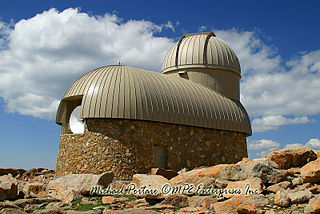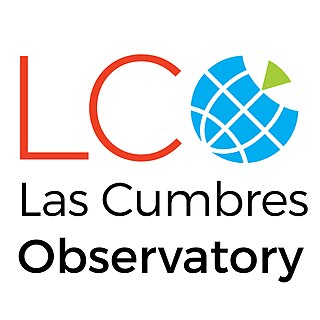
The Mountain Time Zone of North America keeps time by subtracting seven hours from Coordinated Universal Time (UTC) when standard time (UTC−07:00) is in effect, and by subtracting six hours during daylight saving time (UTC−06:00). The clock time in this zone is based on the mean solar time at the 105th meridian west of the Greenwich Observatory. In the United States, the exact specification for the location of time zones and the dividing lines between zones is set forth in the Code of Federal Regulations at 49 CFR 71.

The Faulkes Telescope South is a clone of the Liverpool Telescope and is located at Siding Spring Observatory in New South Wales, Australia. It is a 2 m (79 in) Ritchey-Chrétien telescope. It was designed to be operated remotely with the aim of encouraging an interest in science by young people. It is supported by an altazimuth mount.

Meyer–Womble Observatory (MWO) is an astronomical observatory owned and operated by the University of Denver. It is located near the summit of Mount Evans in the Arapaho National Forest approximately 60 kilometers (37 mi) west of Denver, Colorado (USA). At an elevation of 4,326 meters (14,193 ft), it is the third-highest optical/infrared observatory in the world, and was the highest until the Indian Astronomical Observatory opened in 2001.
Brisa or Briza may refer to:

Behlen Observatory is a research facility and astronomical observatory owned and operated by the astronomy department of the University of Nebraska-Lincoln. It is located in Mead, Nebraska about 38 miles (61 km) northeast of Lincoln, Nebraska and was founded in 1972.

Grant O. Gale Observatory is an astronomical observatory owned and operated by Grinnell College Department of Physics. The observatory is located in Grinnell, Iowa (USA). Constructed in 1984, it is named after Grant O. Gale, a distinguished teacher and curator of the Grinnell Physics Historical Museum. Designed by Woodburn and O'Neil of Des Moines, the building is a 38-foot by 55-foot structure rising 26 feet to the top of the dome. It houses a 24-inch Cassegrain reflecting telescope built by DFM Engineering of Longmont, Colorado. The observatory houses two computer systems: the first controls the telescope and the second accommodates data acquisition and analysis and can be used to store television images. In addition to its primary function as an instructional and research tool, the observatory is also a facility for public viewing of astronomical phenomena under staff supervision.

Kennon Observatory is an astronomical observatory owned and operated by the University of Mississippi. Built in 1939 and located on the university's campus in Oxford, Mississippi (USA), it was named after Dr. William Lee Kennon, a long-serving chair of the department of Physics and Astronomy.

Judson B. Coit Observatory is an astronomical observatory owned and operated by Boston University on the roof of the College of Arts & Sciences at 725 Commonwealth Avenue in Boston, Massachusetts, USA. The observatory is used in undergraduate and graduate courses of the Boston University Department of Astronomy, and for observing projects of the Boston University Astronomical Society.

Melton Memorial Observatory is an astronomical observatory owned and operated by University of South Carolina. It is named after Dr. William Davis Melton and built in 1928. It is located in Columbia, South Carolina (USA).
Brooks Astronomical Observatory is an astronomical observatory owned and operated by Central Michigan University. It is located in Mount Pleasant, Michigan (USA). The observatory was established in 1964 and is located on the roof of the Brooks Hall science building. Both the building and observatory are named for Kendall P. Brooks, instructor of astronomy and other subjects in the period of 1910-1947.

For the mountains in Tajikistan, see the Fann Mountains.

The CINEOS program, started in 2001, is dedicated to the discovery and follow-up of near-Earth objects (NEOs), namely asteroids and comets which periodically approach or intersect the Earth's orbit. In particular CINEOS is addressed to the discovery of Atens and Interior-Earth Objects (IEOs) by extending survey coverage at small solar elongations, and to the discovery of the other kind of NEOs by observing with longer exposures in the opposition region.
The High-Z Supernova Search Team was an international cosmology collaboration which used Type Ia supernovae to chart the expansion of the universe. The team was formed in 1994 by Brian P. Schmidt, then a post-doctoral research associate at Harvard University, and Nicholas B. Suntzeff, a staff astronomer at the Cerro Tololo Inter-American Observatory (CTIO) in Chile. The original team first proposed for the research on September 29, 1994 in a proposal called A Pilot Project to Search for Distant Type Ia Supernova to the CTIO Inter-American Observatory. The original team as co-listed on the first observing proposal was: Nicholas Suntzeff (PI); Brian Schmidt (Co-I); R. Chris Smith, Robert Schommer, Mark M. Phillips, Mario Hamuy, Roberto Aviles, Jose Maza, Adam Riess, Robert Kirshner, Jason Spiromilio, and Bruno Leibundgut. The original project was awarded four nights of telescope time on the CTIO Victor M. Blanco Telescope on the nights of February 25, 1995, and March 6, 24, and 29, 1995. The pilot project led to the discovery of supernova SN1995Y. In 1995, the HZT elected Brian P. Schmidt of the Mount Stromlo Observatory which is part of the Australian National University to manage the team.

Las Cumbres Observatory (LCO) is a network of astronomical observatories run by a non-profit private operating foundation directed by the technologist Wayne Rosing. Its offices are in Goleta, California. The telescopes are located at both northern and southern hemisphere sites distributed in longitude around the Earth. For some astronomical objects, the longitudinal spacing of telescopes allows continuous observations over 24 hours or longer. The operating network currently consists of two 2 meter telescopes, nine 1 meter telescopes, and seven 40 cm telescopes, placed at six astronomical observatories. The network operates as a single, integrated, observing facility, using a software scheduler that continuously optimizes the planned observing schedule of each individual telescope.

The Hirsch Observatory is an astronomical observatory at Rensselaer Polytechnic Institute (RPI) in Troy, New York. It is located on the roof of the Jonsson-Rowland Science Center and is used by members of the Rensselaer Astrophysical Society as well as astronomy students in laboratory exercises. It is frequently opened to the community for public viewing sessions. The observatory's main dome contains a 16" Cassegrain Reflector, with a CCD camera and fully computerized controls. The observatory also owns a variety of smaller scopes and a SBIG Spectrograph. The spectrograph has been used to catalog bright solar spectrum as part of an effort to create an online digital database for astrophysical research. The current director of the observatory is Professor Heidi Newberg.

Fuertes Observatory is an astronomical observatory located on the North Campus of Cornell University in Ithaca, New York. The observatory was designed by L.P. Burnham, Cornell Professor of Architecture and completed in fall of 1917. It was originally used by the Civil Engineering Department as an instructional field office for navigation and surveying. Today, the observatory is primarily used for public outreach, welcoming over two thousand visitors per year with open houses on clear Friday nights.

The SUNY Oneonta College Observatory is an astronomical observatory in Oneonta, New York. The observatory is home to the largest optical telescope in New York: a 1-meter Newtonian reflector. It is also believed to be the one of the largest telescopes open for public observing east of the Mississippi. The telescope was constructed by JMI Telescopes of Lakewood, Colorado.
Brisas Group is a Mexican hotel chain with 10 properties in Acapulco, Cancún, Huatulco, Irapuato, Ixtapa, Manzanillo, Mexico City, Querétaro, and Veracruz. In 2010, Travel + Leisure magazine named one of its properties, Las Brisas Acapulco, as the 7th best Mexican hotel.

Tortugas Mountain Observatory (TMO) is an astronomical observatory owned and operated by New Mexico State University (NMSU). It is located on Tortugas Mountain, also known locally as 'A' Mountain, in southern New Mexico (USA), approximately 8 kilometers (5.0 mi) southeast of Las Cruces and 4 kilometers (2.5 mi) east of the NMSU campus. Founded in 1963 under the supervision of Clyde Tombaugh, the observatory focused on observing the planets. Much of the information captured at TMO is now available through the Planetary Data System's Atmospheres Node, which is managed by NMSU. The two-dome observatory building was completed in 1964, though observing began with one of the telescopes in 1963. A second building, with a larger single dome, was completed at the opposite end of the ridgeline of Tortugas Mountain in 1967. Regular use of TMO ceased in 1999 or 2000, but the observatory equipment was not dismantled. In 2008 it was used for the Lunar CRater Observing and Sensing Satellite project. In 2010, efforts to revive the observatory for use by the American Association of Variable Star Observers began. As of 10 June 2011, work on project was reported to be 60-75% done.










